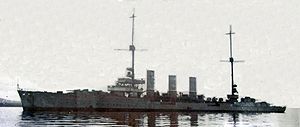Königsberg-class cruiser (1915)

SMS Karlsruhe in Scapa Flow
|
|
| Class overview | |
|---|---|
| Name: | Königsberg class |
| Operators: |
|
| Preceded by: | Brummer class |
| Succeeded by: | Cöln class |
| Built: | 1914–1917 |
| In service: | 1916–1918 |
| Completed: | 4 |
| Lost: | 1 |
| Retired: | 3 |
| General characteristics | |
| Type: | Light cruiser |
| Displacement: |
|
| Length: | 151.40 m (496 ft 9 in) |
| Beam: | 14.20 m (46 ft 7 in) |
| Draft: | 5.96 m (19 ft 7 in) |
| Propulsion: | 31,000 shp (23,000 kW), two shafts |
| Speed: | 27.5 knots (50.9 km/h) |
| Range: | 4,850 nmi (8,980 km; 5,580 mi) at 12 knots (22 km/h; 14 mph) |
| Crew: |
|
| Armament: |
|
| Armor: |
|
The Königsberg class of light cruisers was a group of four ships commissioned into Germany's Imperial Navy shortly before the end of World War I. The class comprised Königsberg, Karlsruhe, Emden, and Nürnberg, all of which were named after light cruisers lost earlier in the war. The ships were an incremental improvement over the preceding Wiesbaden-class cruisers, and were armed with a main battery of eight 15 cm SK L/45 guns and had a designed speed of 27.5 knots (50.9 km/h; 31.6 mph).
Königsberg and Nürnberg saw action at the Second Battle of Heligoland Bight, where Königsberg was hit by a shell from the battlecruiser Repulse. Three of the four ships were to participate in a climactic fleet operation to attack the British Grand Fleet in the final days of the war, but revolts in the fleet forced the cancellation of the plan. Karlsruhe, Emden, and Nürnberg were interned at Scapa Flow after the end of the war, and were scuttled on 21 June 1919, though only Karlsruhe was successfully sunk. The other two ships were beached by British sailors and ceded to the Allies. Königsberg was transferred to the French Navy as a war prize and commissioned as Metz; she served with the French Navy until the 1930s, when she was broken up for scrap.
...
Wikipedia
